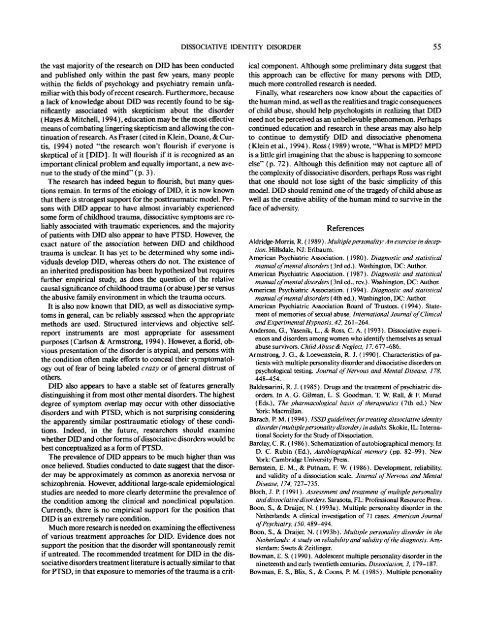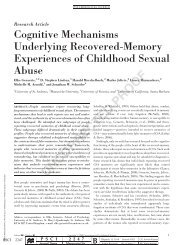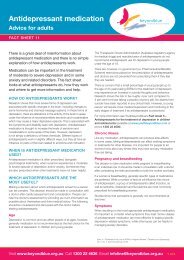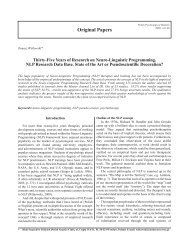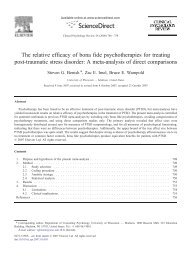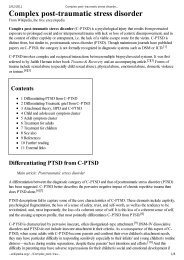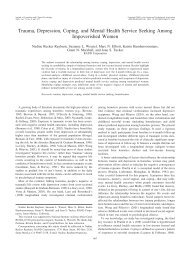The Sociocognitive Model of Dissociative Identity Disorder: A ...
The Sociocognitive Model of Dissociative Identity Disorder: A ...
The Sociocognitive Model of Dissociative Identity Disorder: A ...
Create successful ePaper yourself
Turn your PDF publications into a flip-book with our unique Google optimized e-Paper software.
DISSOCIATIVE IDENTITY DISORDER 55<br />
the vast majority <strong>of</strong> the research on DID has been conducted<br />
and published only within the past few years, many people<br />
within the fields <strong>of</strong> psychology and psychiatry remain unfamiliar<br />
with this body <strong>of</strong> recent research. Furthermore, because<br />
a lack <strong>of</strong> knowledge about DID was recently found to be significantly<br />
associated with skepticism about the disorder<br />
(Hayes & Mitchell, 1994), education may be the most effective<br />
means <strong>of</strong> combating lingering skepticism and allowing the continuation<br />
<strong>of</strong> research. As Eraser (cited in Klein, Doane, & Curtis,<br />
1994) noted "the research won't flourish if everyone is<br />
skeptical <strong>of</strong> it [DID]. It will flourish if it is recognized as an<br />
important clinical problem and equally important, a new avenue<br />
to the study <strong>of</strong> the mind" (p. 3).<br />
<strong>The</strong> research has indeed begun to flourish, but many questions<br />
remain. In terms <strong>of</strong> the etiology <strong>of</strong> DID, it is now known<br />
that there is strongest support for the posttraumatic model. Persons<br />
with DID appear to have almost invariably experienced<br />
some form <strong>of</strong> childhood trauma, dissociative symptoms are reliably<br />
associated with traumatic experiences, and the majority<br />
<strong>of</strong> patients with DID also appear to have PTSD. However, the<br />
exact nature <strong>of</strong> the association between DID and childhood<br />
trauma is unclear. It has yet to be determined why some individuals<br />
develop DID, whereas others do not. <strong>The</strong> existence <strong>of</strong><br />
an inherited predisposition has been hypothesized but requires<br />
further empirical study, as does the question <strong>of</strong> the relative<br />
causal significance <strong>of</strong> childhood trauma (or abuse) per se versus<br />
the abusive family environment in which the trauma occurs.<br />
It is also now known that DID, as well as dissociative symptoms<br />
in general, can be reliably assessed when the appropriate<br />
methods are used. Structured interviews and objective selfreport<br />
instruments are most appropriate for assessment<br />
purposes (Carlson & Armstrong, 1994). However, a florid, obvious<br />
presentation <strong>of</strong> the disorder is atypical, and persons with<br />
the condition <strong>of</strong>ten make efforts to conceal their symptomatology<br />
out <strong>of</strong> fear <strong>of</strong> being labeled crazy or <strong>of</strong> general distrust <strong>of</strong><br />
others.<br />
DID also appears to have a stable set <strong>of</strong> features generally<br />
distinguishing it from most other mental disorders. <strong>The</strong> highest<br />
degree <strong>of</strong> symptom overlap may occur with other dissociative<br />
disorders and with PTSD, which is not surprising considering<br />
the apparently similar posttraumatic etiology <strong>of</strong> these conditions.<br />
Indeed, in the future, researchers should examine<br />
whether DID and other forms <strong>of</strong> dissociative disorders would be<br />
best conceptualized as a form <strong>of</strong> PTSD.<br />
<strong>The</strong> prevalence <strong>of</strong> DID appears to be much higher than was<br />
once believed. Studies conducted to date suggest that the disorder<br />
may be approximately as common as anorexia nervosa or<br />
schizophrenia. However, additional large-scale epidemiological<br />
studies are needed to more clearly determine the prevalence <strong>of</strong><br />
the condition among the clinical and nonclinical population.<br />
Currently, there is no empirical support for the position that<br />
DID is an extremely rare condition.<br />
Much more research is needed on examining the effectiveness<br />
<strong>of</strong> various treatment approaches for DID. Evidence does not<br />
support the position that the disorder will spontaneously remit<br />
if untreated. <strong>The</strong> recommended treatment for DID in the dissociative<br />
disorders treatment literature is actually similar to that<br />
for PTSD, in that exposure to memories <strong>of</strong> the trauma is a critical<br />
component. Although some preliminary data suggest that<br />
this approach can be effective for many persons with DID,<br />
much more controlled research is needed.<br />
Finally, what researchers now know about the capacities <strong>of</strong><br />
the h uman mind, as well as the realities and tragic consequences<br />
<strong>of</strong> child abuse, should help psychologists in realizing that DID<br />
need not be perceived as an unbelievable phenomenon. Perhaps<br />
continued education and research in these areas may also help<br />
to continue to demystify DID and dissociative phenomena<br />
(Klein et al., 1994). Ross (1989) wrote, "What is MPD? MPD<br />
is a little girl imagining that the abuse is happening to someone<br />
else" (p. 72). Although this definition may not capture all <strong>of</strong><br />
the complexity <strong>of</strong> dissociative disorders, perhaps Ross was right<br />
that one should not lose sight <strong>of</strong> the basic simplicity <strong>of</strong> this<br />
model. DID should remind one <strong>of</strong> the tragedy <strong>of</strong> child abuse as<br />
well as the creative ability <strong>of</strong> the human mind to survive in the<br />
face <strong>of</strong> adversity.<br />
References<br />
Aldridge-Morris, R. (1989). Multiple personality: An exercise in deception.<br />
Hillsdale, NJ: Erlbaum.<br />
American Psychiatric Association. (1980). Diagnostic and statistical<br />
manual <strong>of</strong> mental disorders (3rd ed.). Washington, DC: Author.<br />
American Psychiatric Association. (1987). Diagnostic and statistical<br />
manual oj'mental disorders (3rd ed., rev.). Washington, DC: Author.<br />
American Psychiatric Association. (1994). Diagnostic and statistical<br />
manual <strong>of</strong> mental disorders (4m ed.). Washington, DC: Author.<br />
American Psychiatric Association Board <strong>of</strong> Trustees. (1994). Statement<br />
<strong>of</strong> memories <strong>of</strong> sexual abuse. International Journal <strong>of</strong> Clinical<br />
and Experimental Hypnosis, 42, 261-264.<br />
Anderson, G., Yasenik, L., & Ross, C. A. (1993). <strong>Dissociative</strong> experiences<br />
and disorders among women who identify themselves as sexual<br />
abuse survivors. Child Abuse & Neglect, 17, 677-686.<br />
Armstrong, J. G., & Loewenstein, R. J. (1990). Characteristics <strong>of</strong> patients<br />
with multiple personality disorder and dissociative disorders on<br />
psychological testing. Journal <strong>of</strong> Nervous and Mental Disease, 178,<br />
448-454.<br />
Baldessarini, R. J. (1985). Drugs and the treatment <strong>of</strong> psychiatric disorders.<br />
In A. G. Oilman, L. S. Goodman, T. W. Rail, & F. Murad<br />
(Eds.), <strong>The</strong> pharmacological basis <strong>of</strong> therapeutics (7th ed.) New<br />
\brk: Macmillan.<br />
Barach, P. M. (1994). ISSD guidelines for treating dissociative identity<br />
disorder (multiplepersonality disorder) in adults. Skokie, IL: International<br />
Society for the Study <strong>of</strong> Dissociation.<br />
Barclay, C. R. (1986). Schematization <strong>of</strong> autobiographical memory. In<br />
D. C. Rubin (Ed.), Autobiographical memory (pp. 82-99). New<br />
York: Cambridge University Press.<br />
Bernstein, E. M., & Putnam, F. W. (1986). Development, reliability,<br />
and validity <strong>of</strong> a dissociation scale. Journal <strong>of</strong> Nervous and Mental<br />
Disease, 174, 727-735.<br />
Bloch. J. P. (1991). Assessment and treatment <strong>of</strong> multiple personality<br />
and dissociative disorders. Sarasota, FL: Pr<strong>of</strong>essional Resource Press.<br />
Boon, S., & Draijer, N. (I993a). Multiple personality disorder in the<br />
Netherlands: A clinical investigation <strong>of</strong> 71 cases. American Journal<br />
<strong>of</strong> Psychiatry, ISO, 489-494.<br />
Boon, S., & Draijer. N. (1993b). Multiple personality disorder in the<br />
Netherlands: A study on reliability and validity <strong>of</strong> the diagnosis. Amsterdam:<br />
Swets & Zeitlinger.<br />
Bowman, E. S. (1990). Adolescent multiple personality disorder in the<br />
nineteenth and early twentieth centuries. Dissociation, 3, 179-187.<br />
Bowman, E. S., Blix, S., & Coons, P. M. (1985). Multiple personality


